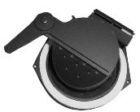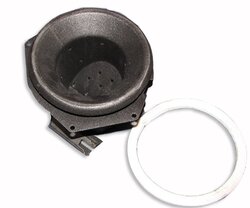I continued to search this site and came across a suggestion to Crack the door a little.. In doing this I now have the "correct" fire..
One of the requisite default safety features on any pellet stove is that the firebox needs to maintain a negative combustion chamber pressure to prevent the back draft of noxious gases into your house.
So, unlike a wood stove, if the negative pressure vacuum safety system is working correctly on a Quad pellet stove, as soon as you 'crack the door a little' it should immediately shut down your pellet feed, and thus the burn cycle, rather than giving you the 'correct fire'. I've heard of folks momentarily 'cracking the door' on a Quad pellet stove to visualize what a 'lazy flame' looks like, (assuming the stove is otherwise running correctly), but not to get the stove to run as you claimed. Did you perhaps mean you 'cracked' the ash pan door as opposed to the stoves firebox door ? Even then, that shouldn't be necessary either to make things run right with your stove.
It does however make me wonder if any stove manufacturer measures the vacuum and auto adjust the combustion motor speed..
When a Quad, or any pellet stove, is functioning correctly, the control box does sense the correct vacuum and auto adjusts the combustion motor speed to the amount of pellets that the control box tells the auger to feed to the fire pot. Tons of R&D have gone into the Quad designs, which have a long history of pellet burning efficiency and even more importantly, pellet burning safety. Helping you get your stove to be both of those things is obviously the end goal here.
Further investigation shows the air inlet through a rectangular hole at the rear behind the bottom of the burn pot.
Your fire pot has seven or so smaller sized air holes along the sloped section of the fire pot, and seven or eight larger sized air holes scattered around the fire pot body. See the attached pics below.
Those holes should be the only air inlet source into the fire pot, besides the slit for the igniter. So I'm not sure exactly what you're referring to as the "air inlet through the rectangular hole at the rear behind the bottom of the burn pot" is.
You have a fire pot 'trap door' mechanism that swings open via a pull knob and spring linkage that dumps the fire pot ash into the ash pan below. This 'trap door' needs to be fully closed to assure the air is moving through the fire pot air holes and not through a partially open 'trap door'. Is the 'rectangular hole' you mention possibly your trap door partially stuck open?
I will end up fabricating a variable reducer.
You should not have to fabricate a variable reducer if you have the three things a pellet stove needs to burn pellets correctly - correct fuel delivery, absence of air leaks / presence of vacuum, and the absence of any venting restrictions. From the info you've given, I believe you have a problem with one or a combination of several of those 3 issues.
I'm going to 'tag team' your post thread with a Quad technician who posts regularly on here, @
kappel15, aka 'kap', as well as TJ, @
tjnamtiw , who is also excellent on anything Quad related, and bring them into the loop so they can better ascertain what's going on with your stove, OK?




